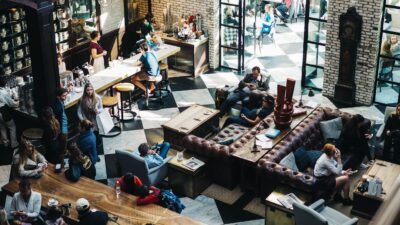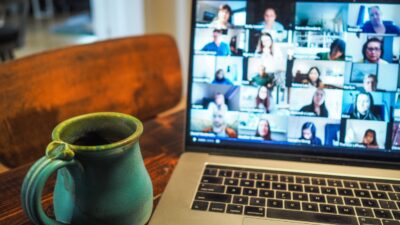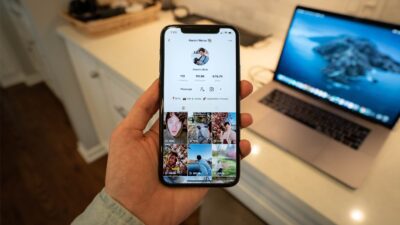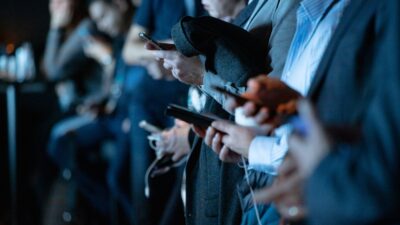Sandra Peter and Kai Riemer

Hybrid work on The Future, This Week
This week: hybrid work models, and their hidden complexities and implications in the wake of the COVID-19 pandemic.
Sandra Peter (Sydney Business Insights) and Kai Riemer (Digital Disruption Research Group) meet once a week to put their own spin on news that is impacting the future of business in The Future, This Week.
The story this week
09:03 – companies reorganise for hybrid work
Other stories we bring up
France bans short haul flights
Around 2.4% of global CO2 emissions come from aviation
150 million people slipped out of the global middle class
Our megatrends: impactful technology, demographic change, rapid urbanisation, amplified individuals, economic power shift, climate and resource security
Our special series on China’s post-pandemic recovery
750 million genetically engineered mosquitoes to be released in Florida
Our previous conversation on The Future, This Week on genetically engineered diamondback moths
5 billion bananas get thrown away each year
cryptocurrency exchange Coinbase IPO with expected valuation of $US100 billion
Hybrid work research from Fujitsu
Hybrid work research from Microsoft
Hybridity considerations from HBR
The right to disconnect and Victoria Police
The right to disconnect in different jurisdictions
The right to disconnect in Europe
Our previous conversations on Corona Business Insights on productivity and remote work, office changes, Zoom fatigue and Gen Z
Follow the show on Apple Podcasts, Spotify, Overcast, Google Podcasts, Pocket Casts or wherever you get your podcasts. You can follow Sydney Business Insights on Flipboard, LinkedIn, Twitter and WeChat to keep updated with our latest insights.
Our theme music was composed and played by Linsey Pollak.
Send us your news ideas to sbi@sydney.edu.au.
Dr Sandra Peter is the Director of Sydney Executive Plus and Associate Professor at the University of Sydney Business School. Her research and practice focuses on engaging with the future in productive ways, and the impact of emerging technologies on business and society.
Kai Riemer is Professor of Information Technology and Organisation, and Director of Sydney Executive Plus at the University of Sydney Business School. Kai's research interest is in Disruptive Technologies, Enterprise Social Media, Virtual Work, Collaborative Technologies and the Philosophy of Technology.
Share
We believe in open and honest access to knowledge. We use a Creative Commons Attribution NoDerivatives licence for our articles and podcasts, so you can republish them for free, online or in print.
Transcript
Disclaimer We'd like to advise that the following program may contain real news, occasional philosophy and ideas that may offend some listeners.
Sandra So what do you want to talk about this week?
Kai Well, France is on the brink of banning certain domestic short-haul flights during the pandemic, a lot of flights were grounded, and the carbon pollution from aviation dropped by roughly 60%. And an article in Gizmodo reports that France wants to make some of that permanent by banning all short-haul flights that can be replaced with a train ride of no longer than two and a half hours.
Sandra And I suppose this is for the sake of the climate, right?
Kai Yeah, I mean, we know that aviation globally only contributes a bit less than 3%. But short-haul flights are amongst the worst polluters. And so France is trying to take off the table some of those worst offending routes, like Paris to Bordeaux or Strasbourg, and replace them with train rides. And arguably, France can do this because they have a very mature fast rail network. So they're in a good position to replace some of those flights, and they have identified this as one measure for them to achieve their climate goals.
Sandra And we've seen similar trends in China that's also rapidly expanding its high-speed rail network that will actually give you time savings as well. If you're traveling, for instance, from Beijing, to Shanghai, but of course, in many places, including Australia and the US, this is really not an option as we like high-speed trains and have very little rail infrastructure to compensate for short-haul flights. There was another really interesting story I wanted to bring up, which had to do with the global middle class. We know one of the enduring mega trends for the past 30 years or so has been the rise of the middle class. It's part of our economic power shift megatrend, along with rapid urbanisation and demographic change, impactful technology, climate and resource security and amplified individuals. And we know that for more than 25 years, the global middle class has been on the rise and predictions are that by 2030, there'll be about 5 billion people in the middle class. And they're a significant megatrend in that this global mass affluent community does possess significant purchasing power. And we knew that about two thirds of them reside in Asia Pacific. And there was interesting news via Bloomberg Businessweek, that millions are now tumbling out of the global middle class. And this is really a historic event, this hasn't happened in the last three decades, but it's estimated that about 150 million people slipped out of the global middle class last year. And this reduction was predominantly in places like India, South Asia, and Africa.
Kai And there has been some reduction in places like Europe or Central Asia, and China have about 3-4%. But that is much lower than the average in the developing world, which has seen a reduction of about 7%.
Sandra And this is one that we're gonna keep an eye on because clearly this presents a challenge to global post-COVID recovery. And we know that China is home to about a third of the world's middle class and they do appear to be recovering quite quickly. We actually have a few resources...
Kai Oh, and that should tie in with your series that you've done on SBI on China's post-pandemic recovery.
Sandra Indeed, we'll include it in the shownotes. We did a special with four China experts, a businessman, an academic, a diplomat, and an economist that walked us through China's post-pandemic story. So you can hear from the likes of Kishore Mahbubani was the former president of the UN Security Council, or Dr Weijian Shan the Chairman and Chief Executive of China's largest insurer, PAG.
Kai Now I have another story with large numbers, this one is about mosquitoes. Genetically modified mosquitoes are about to be released in Florida Keys, and 750 million of them, in order to control and bring down the population of mosquitoes that are carriers of several deadly diseases such as Zika, dengue fever or yellow fever.
Sandra So is it a bit like the moths we talked about last year?
Kai It's pretty similar. So, what you want in mosquitoes is control the female offspring, because it's only female mosquitoes of course that bite because they need blood to mature their eggs. And what this genetic modification does is it means that the female larvae can't actually mature to full-growth they would die-off, whereas the male mosquitoes would survive and then over several reproduction cycles the hope is that the population drops down significantly, especially in the female ones.
Sandra Right, and we discussed moths a while back, these genetically modified diamondback moths, which are obviously a huge pest, they cost billions and billions of dollars every year, and they're largely resistant to most insecticides. And in this case, it would be also the female offspring that would die during the caterpillar stage and the male offspring that would carry on the gene.
Kai And in the case of the moths, it was, of course, agriculture that was going to be the beneficiary because these moths attack crops. As for the mosquitoes, on the one hand, there's good news, trials in Brazil have shown that the population could be reduced by as much as 95%, but there always remains an uneasiness that brings these issues to the fore, and that is that genetically modified species are introduced into natural habitats and what follow-on effects that might have.
Sandra And there's a number of other stories that I'm really tempted to bring up like the op-ed in the Chicago Tribune that talks about 5 billion bananas getting thrown out each year in the US alone, that is 5 billion bananas get thrown away each year. And that's part of a larger trend of food wastage. In the US alone 35% of food goes unsold or uneaten, so huge food wastage. But all these numbers seem to be on the rise, for the bananas, that's about 12% up. And that's really not good news, given that we are set to need to produce about 60-100% more food to be able to feed our growing population. And not just bananas, we should be probably talking about the public listing of the cryptocurrency exchange Coinbase.
Kai So this is breaking news, because it listed today as we are recording and Coinbase is now valued on its first day at $100 billion, which makes it the most valuable exchange listed.
Sandra To make it clear. Coinbase is a US-based cryptocurrency exchange, and there's over 50 million people who use it to buy and sell cryptocurrencies. And the idea here really is that Coinbase is trying to position themselves as the party that will interface between kind of the real world and traditional investors, and the digital crypto world, including things like NFTs, that again we've talked about a couple of weeks ago, and we'll put the links in the shownotes. And to be fair, there aren't that many competitors out there for the likes of Coinbase at the moment where it's a trusted company that has worked for a very long time with regulators rather than in the what has been the wild west of cryptocurrencies. But this is something that we really need to come back to and discuss at length.
Kai In particular, because a successful listing of Coinbase will make the name more popular, will likely drive more customers to crypto for the first time, and therefore do a lot to legitimise this market as a target for more traditional investors, and also, of course, institutional investors. There have been a lot of stories around one particular topic,
Sandra Hybrid stuff, hybrid work, hybrid workplace, hybrid office.
Kai The post-COVID world of work, which is currently very much in flux.
Sandra And since this has been everywhere, from places like the BBC and the Wall Street Journal, and HBR, to companies like Ford and Fujitsu and Microsoft making a lot of announcements in this space, we realised we have to talk about this topic.
Kai Let's do this.
Sandra Let's do this.
Intro From The University of Sydney Business School, this is Sydney Business Insights, an initiative that explores the future of business. And you're listening to The Future, This Week where Sandra Peter and Kai Riemer sit down every week to rethink and unlearn trends and technology and business. They discuss the news of the week, question the obvious explore the weird and the wonderful.
Sandra We picked an article today from the Wall Street Journal titled, "Ford Retools Headquarters for Hybrid Work. Awaiting returning staff: A check-in app, ambient sensors to alert managers of crowded workspaces and videoconferencing carts".
Kai And the story talks about the ways in which the company is trying to make for a safe return to the office knowing that not everyone will permanently return, and not everyone will return at once. And so the company has to create both infrastructure around the office that allows working under the remaining COVID conditions but also to include, as much as possible, those who are working remotely.
Sandra And in the case of Ford in this article that's about 30,000 employees from sales and marketing to human resource, resources staff but also designers and engineers. But we really could have picked any of a number of stories. There were similar stories this week coming out of Fujitsu, last week coming out of Microsoft, or any of a host of other articles just commenting on hybrid work or hybrid office in general. But the thing that sticks out with all these articles is that whilst they are really stats heavy, all of them give us percentages for people working, people returning, people wanting to stay, wanting to come back, wanting flexible time, not wanting flexible time. So whilst there are stats galore, they all have a different focus, and really understanding what hybrid work entails for most of these companies is not something that any of these articles make clear.
Kai And there's a stat for that too, Computer Weekly reports that 48% of companies are still working on figuring out what their hybrid work model should be. So hybrid has really become the buzzword here, the label under which a lot of these changes to work models are being discussed. And while there are no clear models yet, we will unpack for you the complexity in this space.
Sandra Yeah, and really highlight the few areas, whether that has to do with scheduling or wellbeing, or onboarding, culture, infrastructure, just really highlighting some of the aspects that help us better understand how to go about doing hybrid work.
Kai So let's start by talking about what we actually mean by hybrid. So hybrid means two or more different models are being combined. So work in the office and work away from the office. But that can take different forms.
Sandra So on the one hand, you have organisations where it's pretty clear who are the people who are always in the office, and who are always working from home or working remotely, and those things tend not to change over time.
Kai So it's a fairly stable model, where you just have two worlds, and you cater for both, and you bring them together. But then there's a more flexible form of hybrid work, where a lot of people tend to float in and out of the office, sometimes working from home, sometimes coming to the office, or to even increase the flexibility to work off-site, in coffee shops, in any kind of places.
Sandra And for many of the organisations that made the big jump to flexible work to hybrid work as a result of the COVID-19 pandemic, that is the reality. No clear schedules yet, various people for different models and companies really trying to figure out what works best for them and what this looks like in the long-term.
Kai And this is not a new trend of course, working from home or working remotely has always existed, the idea to go home and work on certain tasks that need a quiet work environment, for example, but the scale at which we operate now is a very different one.
Sandra So you're right, since this is a stats-heavy episode, we know that for the past 20 years there was about a fivefold increase in people working flexible hours, from about 10% to about 50% since the year 2000. But that obviously ended up in 100% of us working from home at the height of the pandemic. And many companies afterwards embracing either a permanent working from home model, as is the case with many of the tech companies that still have most of their workforce at home, or indeed for many companies with working from home as a part-time option for their staff. And the numbers there are about 80% of company leaders plan to have their staff working from home part-time and those are numbers coming out of Gartner.
Kai And of course we're painting a picture here that focuses on office-centric work. The reality is of course very different in agriculture or construction where many workers have to be on site of course.
Sandra One of the first challenges of course with working from home has been that of infrastructure. And working from home does not only mean having an ergonomic chair and a good laptop, it of course means having the right internet connection to access company resources, to have proper video conferencing equipment, whether that's hardware software or high-speed internet, and of course, access to company systems.
Kai So in the Wall Street Journal article it was mentioned that within the office, Ford provides video conferencing carts which have fairly sophisticated equipment, electronic whiteboards, things that really allow for a professional video conferencing experience. And the article makes the point that this has to translate through to people's at-home environment, that companies have to much more deliberately treat the home office as an extension of the office and therefore not leave it up to the employee to look after or purchase their equipment.
Sandra And that's of course provided that your home situation allows for working from home. For some people it is working from a coffee shop or from a co-working space, which would further increase the variability in infrastructure available.
Kai Yeah. And when it comes to collaborating and video conferencing, it's usually the lowest common denominator that determines the quality. Speaking of which, a similar situation exists timewise, when we think about scheduling in a hybrid work environment where people not only work offsite or onsite, but also at different times as we have flexible work arrangements, it becomes increasingly harder to determine who is available at what time to schedule synchronous get-togethers, meetings or meetups.
Sandra So we end up actually doing a lot more stuff asynchronously. So we've seen, even anecdotally in our own team, we've increased the use of Slack a lot, at the expense of talking to someone in real time.
Kai Or in the Business School, the use of Teams spaces to share documents to have textual conversations, which of course can come with a loss of context or a loss of immediacy when problems need to be solved quickly and can therefore introduce frustrations and disconnects in conversations.
Sandra And speaking of scheduling, we saw coming out of the Microsoft research that we brought up last week, that they've also seen an increase in use of instant messaging outside of business hours. So there was reported 52% increase in messaging in the 6pm to midnight time period.
Kai And so speaking of disconnect, this has led in Australia now to a push by Australian unions for the so-called 'right to disconnect', the right of workers not to be available outside of working hours.
Sandra And this has come after the Victoria Police employees won the right to disconnect in their most recent workplace negotiation. And Australia is not the first one to do this. Before we all worked from home, there has been legislation in other parts of the world with regard to the right to disconnect, such as in France, where it's been legislated since 2017 for companies with more than 50 employees that staff don't have to send or answer emails after work. As well as Ireland and the UK looking to legislate for the right to disconnect.
Kai But of course, this was easier when we had a stable work model where most people would work office hours in the office, 9-5, and only a few people would work offsite and only a few people would actually work at home. Now that we're in a hybrid model, where everything has become much more flexible, it is much harder to define or adhere to what is core office hours or working hours, when many people actually enjoy and have made it part of their workday to have flexibility to work early in the morning, maybe have a larger break in midday, and then work into the evening hours. If we superimpose on to a new world of flexibility traditional 9-5 core working hours, we might actually increase the complexity and take a certain freedom away from both the organisation and the workers.
Sandra Because of course having autonomy over the hours at which you work was one of the main reasons people would work from home, so they wouldn't have to necessarily appear to the 9-5 work hours.
Kai And since a lot of work is collaborative and social workers might want to actually communicate with each other after hours, so to speak. So the question then becomes, is it a right to disconnect, or do we make it an obligation to disconnect? Which again, might impede that new-won flexibility and compromise the idea of hybrid work models.
Sandra And one of the problems here is that it gets really murky when you try to untangle the benefits of flexibility and working outside traditional working hours with the fact that working from home, we know has increased the duration of the working day for most people. The average across the many stats that we've come across, whether they come via companies like Microsoft or universities like Harvard, has been almost an hour of extra work per day have been performed with people moving to a working from home environment. So once you try to untangle these effects, it becomes really difficult to figure out, both from an organisational point of view and from an employee point of view, what do you prioritise? Is it the flexibility that then leads to long working hours? Or is it the right to disconnect which then takes away a lot of the advantages of being able maybe to turn off your computer at three o'clock and spend time with your kids coming home from school?
Kai So it creates a lot more overhead and coordination and planning and making explicit what should be the rules of work. So it might well be that organisations grant the right to disconnect but that they wouldn't impose core working hours 9-5, but that everyone can disconnect for some periods of time to avoid burnout. Because it has, of course been shown that there's been a large drop in wellbeing and work/life balance during COVID, and the work from home scenarios that we've all been living through.
Sandra And here is probably a good time to mention something that is conspicuously lacking from most of these hybrid work, hybrid office articles, but that is, on the other hand, very much present in the working from home research that's been done since the onset of the pandemic. And that is that all these benefits around flexible work, working from home, hybrid office, do not accrue equally to everyone. And it turns out that the benefits are experienced less by women than by men, with women working a lot more as they undertake more housework than men. But even more surprisingly, these benefits are not evenly spread between bosses and subordinates.
Kai Microsoft research has found that while 61% of managers say they thrive in this new work from home, remote hybrid environment, their subordinates are thriving at a rate of 23% less than their managers.
Sandra So the benefits accrue unequally, not only along traditional lines that we would expect, but also in new ways that seem to be unique to hybrid workplaces.
Kai And it is interesting to think about what contributes to this. So one would be that managers, people in higher levels of the hierarchy, usually have more job security, have less financial insecurity, they're often with the company for longer so they know the place better, they know better what to do. They know their role better, they have more autonomy over their job, and they have more overview of the work environment, they're in touch with many of their subordinates. Whereas people on lower levels can feel much more isolated and experience more anxiety and uncertainty about their own situation.
Sandra And connections is incidentally one of those key issues with the hybrid work or the hybrid office in the long-term.
Sandra For example, a study by Fujitsu has found that 84% of workers said that they miss socializing with their colleagues in this work environment. And 59% are worried that without face-to-face interaction they would not feel appreciated in their roles, that their work wouldn't be recognised as much. So a real worry about the connection that people have when working remotely.
Sandra And we'll also include an HBR article in the shownotes that talks about how employees who are seen are more likely to come to mind when there is new work or new projects, or when it's time to recognise people who have done work, or indeed when identifying who needs help or who needs additional support.
Kai So again, creating visibility, creating connection, creating awareness for what's going on and what each employee does, requires a lot more overhead and coordination work.
Sandra But I think this relationship aspect to hybrid work is not just something for the short-term, it's also a very important consideration for the long-term for a number of reasons that go beyond visibility. And one of them is of course to do with innovation and creativity. We know that it is face-to-face meetings that foster innovation and creativity, and there's a lot of research to support that that we'll include in the shownotes. But also the fact that informal meetings or the in between meeting conversations around the water cooler, or in front of the elevator, outside of the doors to the office, are the bedrock of building trust and long-term relationships and networks within organisations.
Kai And so again, the study reported in Computer Weekly found that 60% of C-suite managers report that keeping and building the company culture was a key issue of concern under this new hybrid work regime, precisely because relationships and trust. And these informal gatherings do not happen organically. Organisations tend to become more fragmented, silos can establish much more easily, and there can be a rift between those coming to the office more frequently and those who don't.
Sandra And of course, all articles advise, you know, investing a lot of time in making sure that people who work remotely feel as included as people who are present onsite. But this of course, in many cases is not as realistic. And even for the companies that pursue this, this is extremely difficult to achieve. Creating virtual spaces that encourage serendipity as they would in a physical environment is very, very costly. We know from our chat with Marc Stears a couple of weeks ago that online communication is very bad at conveying values or character, which are crucial for the building of long-term relationships. And we also know that it is a lot more taxing to try to do this. So work intensity increases for people who are present on these platforms, and will include all the research around Zoom fatigue, and how to try to overcome it in the shownotes.
Kai And long-term this is compounded by the fact that many people who switch jobs have to onboard into these hybrid, into these remote environments. The same study in Computer Weekly found that 48% of C-suite audiences say that remote onboarding is a key issue of concern, not just for the organisation, but of course also for those who need to join an organization that they cannot explore by walking around the corridors and tapping into offices and meeting people in the coffee shop or the canteen.
Sandra And long-term this is likely to be very significant. The PwC study said more than half the workers say they want to work from home at least three days a week. For many of us, we're drawing on social capital that we've built up over the years with our colleagues at work. But once a couple of years pass in this hybrid work environments, there is less and less organisational knowledge or personal relationships to draw on.
Kai And so again, while this takes more deliberate, explicit leadership, it might also turn out that the office is more important than we thought, not just as a locus of work, or a source of power, but also as the space in which culture actually emerges and onboarding happens, and these relationships are built.
Sandra But that's all we have time for today from our physical podcast studio here with Megan.
Megan Woohoo!
Kai Thanks Megan, and thanks for listening.
Sandra Thanks for listening.
Outro This was The Future, This Week, an initiative of The University of Sydney Business School. Sandra Peter is the Director of Sydney Business Insights and Kai Riemer is Professor of Information Technology and Organisation. Connect with us on LinkedIn, Twitter and Flipboard, and subscribe, like or leave us a rating wherever you get your podcasts. If you have any weird and wonderful topics for us to discuss, send them to sbi@sydney.edu.au.
Close transcript







